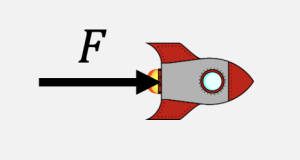20 Motion Subject to a Constant Force
Last chapter we learned about Newton’s law: ![]() . With this equation, we can determine how objects move when subject to forces. We start with the simplest possible case: how does an object subject to a constant force move?
. With this equation, we can determine how objects move when subject to forces. We start with the simplest possible case: how does an object subject to a constant force move?
Let’s start by thinking about the implications of Newton’s law for an object subject to a constant force.
This result is such an important fact, I will write it down again:
The motion of objects subject to a constant force is given by the kinematic equations.
Let’s use this to solve a problem.
Exercise 20.1: Motion Subject to a Constant Force
A rocket of mass ![]() starts out at rest in outer space. Whatever direction the rocket is pointing in, we will call that the
starts out at rest in outer space. Whatever direction the rocket is pointing in, we will call that the ![]() axis. The rocket turns on its engines, which push it with a constant force
axis. The rocket turns on its engines, which push it with a constant force ![]() . Determine the position of this rocket as a function of time.
. Determine the position of this rocket as a function of time.
We will do this problem together following our usual steps.
Step 1: Draw a picture. From this point forth, your drawing needs to include all forces pushing the objects of interest.
 In this case, all we know about the force is that it is pushing the rocket. Thus, I would draw the force as an arrow that is “pushing the rocket” from behind, as shown at right.
In this case, all we know about the force is that it is pushing the rocket. Thus, I would draw the force as an arrow that is “pushing the rocket” from behind, as shown at right.
Use this to make a complete drawing of the problem. I explain my drawing in the video below.
Step 2: Find relations. To solve force problems, we always start by writing Newton’s law for each object and for each axis.
Newton’s law is always a relation we can use: it is a law of physics. Moreover, when the force is constant, you also know that the motion of the object can be described using the kinematic equations. Use all of this to setup all of the relations you know must be true for this problem.
Step 3: Solve unknowns. As it turns out, in this problem we were are asked to find ![]() , which is exactly what came out of our “relations” part: we have nothing left to do!
, which is exactly what came out of our “relations” part: we have nothing left to do!
The basic pattern you saw in the previous plot will be the same for every force problem we solve in this class. Specifically:
- when given a force problem, we draw a picture that includes all forces.
- We then use Newton’s laws to determine the objects acceleration.
- If the net force on an object is constant, the objects motion is given by the kinematic equations.
We will get plenty of practice with this setup over the coming chapters.
Key Takeaways
